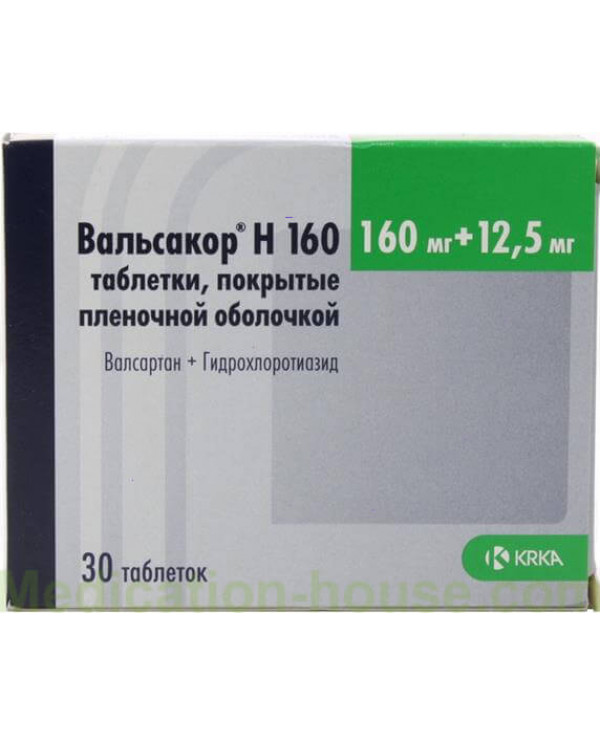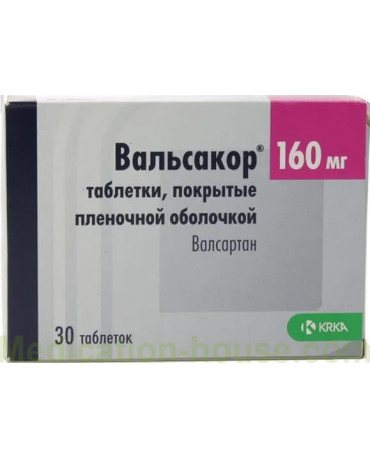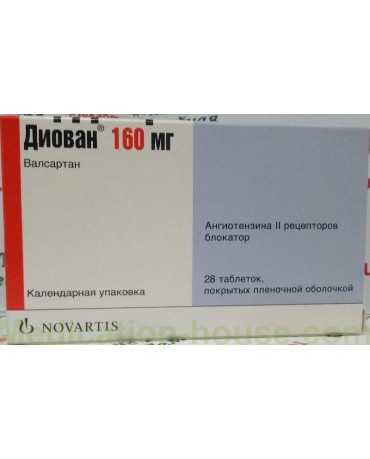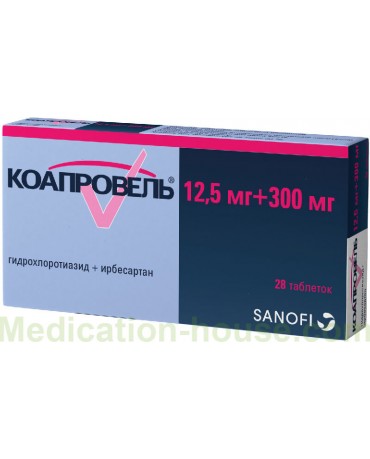Valsacor H user manual
You can buy Valsacor H on this page
Structure
1 film-coated tablet contains:
active ingredients: valsartan 80 mg, hydrochlorothiazide 12.5 mg,
excipients: MCC; lactose monohydrate; magnesium stearate; croscarmellose sodium; povidone; colloidal anhydrous silicon dioxide,
film shell: hypromellose; titanium dioxide (E171); macrogol 4000; iron dye red oxide (E172); iron dye yellow oxide (E172)
Pharmacodynamics
Valsacor H is a combined antihypertensive agent.
Valsartan. Is a selective antagonist of angiotensin II receptors for oral administration, non-protein nature.
It has a selective antagonistic effect on the AT1 subtype. The blockade of AT1 receptors results in an increase in the plasma concentration of angiotensin II, which can stimulate unblocked AT2 subtype receptors, which balances the effects associated with the blockade of AT1 receptors. Valsartan has no AT1 receptor agonist activity. Its affinity for the AT1 subtype receptors is about 20,000 times greater than for the AT2 subtype. Valsartan does not inhibit ACE, also known as kininase II, which converts angiotensin I to angiotensin II and degrades bradykinin. Due to the lack of effect on ACE, the effects of bradykinin and substance P are not potentiated, therefore, when taking angiotensin II receptor antagonists, the development of dry cough is unlikely. Valsartan does not interact with and does not block other hormone receptors or ion channels involved in the regulation of the function of the cardiovascular system.
In the treatment of hypertension, valsartan lowers blood pressure without affecting heart rate.
After oral administration of a single dose of valsartan, the antihypertensive effect develops within 2 hours, and the maximum decrease in blood pressure is achieved within 4-6 hours. The antihypertensive effect of valsartan lasts for 24 hours. With repeated prescriptions of valsartan, the maximum decrease in blood pressure, regardless of the dose, is achieved after 2-4 weeks and remains at the achieved level during long-term therapy. The combination with hydrochlorothiazide allows you to achieve a significant additional decrease in blood pressure.
A sudden discontinuation of valsartan is not accompanied by a withdrawal syndrome (a sharp rise in blood pressure or other undesirable clinical consequences).
Hydrochlorothiazide. Thiazide diuretic, the diuretic effect of which is associated with impaired reabsorption of sodium, chlorine, potassium, magnesium, water ions in the distal nephron; delays the excretion of calcium ions, uric acid. Has a hypotensive effect, which is due to the expansion of arterioles. Virtually no effect on normal blood pressure. The diuretic effect develops within 1–2 hours after taking the drug inside, reaches a maximum after 4 hours and lasts for 6–12 hours. The antihypertensive effect occurs within 3–4 days, but it may take 3–4 weeks to achieve optimal therapeutic effect.
Pharmacokinetics
Valsartan
It is rapidly absorbed after oral administration, but the degree of absorption varies widely. The average value of the absolute bioavailability of valsartan is 23%. Tmax - 2 hours. When the drug is taken orally, once a day, its accumulation is insignificant. Plasma concentrations of valsartan are the same in men and women.
Valsartan actively binds to serum proteins (94–97%), mainly to serum albumin. The equilibrium volume of distribution of the drug is small, about 17 liters. Plasma clearance is relatively low (about 2 L / h) when compared to hepatic blood flow (about 30 L / h).
Metabolized by the isoenzyme CYP2C9.
T1 / 2 is 9 hours. It is excreted mainly unchanged through the intestines (70%) and kidneys (30%). When taking valsartan with food, the AUC decreases by 48%. However, 8 hours after ingestion, plasma concentrations of valsartan taken on an empty stomach and with food are the same. The decrease in AUC is not accompanied by a clinically significant decrease in the therapeutic effect of valsartan, therefore the drug can be used regardless of food intake.
Hydrochlorothiazide
After oral administration, the absorption of hydrochlorothiazide is 60-80%. Cmax of hydrochlorothiazide in the blood is reached 2 hours after oral administration. Plasma protein binding - 40–70%.
Hydrochlorothiazide is not metabolized and is rapidly excreted through the kidneys (more than 95%). T1 / 2 is 6-15 hours.
Special patient groups
Patients with impaired renal function. Given that the renal clearance is only 30% of the total clearance, in patients with impaired renal function, no dose adjustment is required. Because the degree of binding of valsartan to blood plasma proteins is high, its excretion during hemodialysis is unlikely.
Patients with impaired liver function. About 83% of valsartan is excreted through the intestines, mainly unchanged. Valsartan does not undergo significant biotransformation, therefore its systemic effect does not correlate with the degree of liver dysfunction. In this regard, in patients with hepatic insufficiency of non-biliary origin and in the absence of cholestasis, a change in the dose of valsartan is not required. In patients with biliary cirrhosis or obstruction of the biliary tract, the AUC of valsartan increases by about 2 times. Valsacor H 160 is not recommended for patients with impaired liver function.
Elderly patients. Some elderly patients showed a slightly greater systemic effect of valsartan compared with young volunteers; however, it has not been established whether these differences are of clinical significance. The systemic clearance of hydrochlorothiazide is reduced in elderly patients compared to young patients.
Indications
Arterial hypertension in patients for whom combination therapy is indicated.
Contraindications
hypersensitivity to valsartan, hydrochlorothiazide, sulfonamide derivatives and other components of the drug Valsacor H;
pregnancy and lactation;
severe liver dysfunction, biliary cirrhosis and biliary obstruction (cholestasis);
anuria, severe renal dysfunction (Cl creatinine
hemodialysis;
hypokalemia, hyponatremia, hypercalcemia or hyperuricemia with clinical manifestations refractory to adequate therapy;
age up to 18 years (the effectiveness and safety of valsartan in children has not been established);
galactose intolerance, Lapp lactase deficiency or glucose / galactose malabsorption syndrome.
With care: concomitant use of potassium preparations, potassium-sparing diuretics, potassium-containing substitutes for table salt and other drugs that can increase the level of potassium in the blood (for example, heparin), chronic heart failure - NYHA functional class IV, renal failure (Cl creatinine> 30 ml / min (0.5 ml / s)), bilateral or unilateral stenosis of the renal arteries or stenosis of the artery of a single kidney, condition after kidney transplantation, conditions accompanied by a decrease in BCC and / or hyponatremia (including diarrhea, vomiting), primary hyperaldosteronism , stenosis of the aortic and mitral valves, hypertrophic obstructive cardiomyopathy (GOKMP), systemic lupus erythematosus (SLE), hypersensitivity to other angiotensin II receptor antagonists, allergic reactions and bronchial asthma.
Method of administration and dosage
Inside, regardless of food intake, the frequency of intake is 1 time per day. Valsacor H can be combined with other antihypertensive drugs. Treatment should be started with minimal doses of the drug.
For patients who have not reached the target blood pressure level during monotherapy with valsartan or hydrochlorothiazide, a fixed combination is recommended - Valsacor H 80 (80 / 12.5 g). In case of insufficiency of the hypotensive effect, it is possible to increase the dose of the drug to the maximum daily dose - 2 tablets Valsacor H 80.
The maximum antihypertensive effect of Valsacor H 80 (80 / 12.5 mg) develops within 2-4 weeks.
Patients with impaired renal function (creatinine clearance> 30 ml / min (0.5 ml / s)) do not need to change the dose of the drug.
The maximum recommended daily dose of valsartan in patients with mild or moderate impairment of liver function of non-biliary origin is 80 mg (1 tablet / day of Valsacor H 80).
Elderly patients do not need dose adjustment.
Application during pregnancy and lactation
Valsartan. The use of angiotensin II receptor antagonists is not recommended during the first trimester of pregnancy. The drug is contraindicated in the II-III trimesters of pregnancy, since the use during this period of pregnancy can cause fetotoxic effects (decreased renal function, oligohydramnios, slowing of ossification of the fetal skull bones) and neonatal toxic effects (renal failure, arterial hypotension, hyperkalemia). If, nevertheless, the drug was used in the II – III trimesters of pregnancy, then it is necessary to conduct an ultrasound of the kidneys and bones of the fetal skull.
When planning a pregnancy, it is recommended that the patient be transferred to alternative antihypertensive therapy, taking into account the safety profile.
When pregnancy is confirmed, the drug should be canceled as soon as possible.
There is no data on the excretion of valsartan in breast milk. However, valsartan is known to pass into the milk of lactating rats.
Hydrochlorothiazide is excreted in breast milk. Therefore, if necessary, drug therapy during lactation should be canceled breastfeeding.
Side effects
The classification of the incidence of side effects of the World Health Organization (WHO): very often -> 1/10; often - from> 1/100 to 1/1000 to 1/10,000 to
Adverse events were generally mild and transient.
From the side of the central and peripheral nervous system: often - general weakness; sometimes - increased fatigue, asthenia, dizziness, incl. postural, vertigo, insomnia; rarely - headache, depression, paresthesia, neuralgia; very rarely - fainting (when used after myocardial infarction).
From the respiratory system: often - nasopharyngitis; sometimes - infections of the upper respiratory tract, rhinitis, sinusitis, cough; very rarely - respiratory distress syndrome with pneumonitis and pulmonary edema.
From the side of the cardiovascular system: sometimes - chest pain; often - a marked decrease in blood pressure and orthostatic hypotension; very rarely - arrhythmias; potentially possible - peripheral edema.
From the digestive tract: often - diarrhea; sometimes - nausea, dyspepsia, abdominal pain; rarely - gastroenteritis, loss of appetite, constipation; very rarely - pancreatitis, intrahepatic cholestasis, jaundice.
On the part of the skin and subcutaneous fat: rarely - skin rash, photosensitivity; very rarely - alopecia.
From the side of the musculoskeletal system: sometimes - pain in the back, limbs, sprains and tears of ligaments and muscles or muscle tendons, arthritis, arthralgia; rarely - myalgia, muscle weakness, muscle cramps.
From the genitourinary system: sometimes - decreased libido, impotence (less than 1%), urinary tract infections, viral infections, increased frequency of urination; very rarely - impaired renal function.
From the senses: sometimes - visual impairment; rarely - tinnitus, conjunctivitis.
Allergic reactions: very rarely - angioedema, urticaria, skin rash, itching, hypersensitivity reactions, including serum sickness and necrotizing vasculitis, toxic epidermal necrolysis (Lyell's syndrome), lupus-like reactions, exacerbation of the course of SLE.
Laboratory indicators: often - hyperkalemia, hypokalemia, hyponatremia, hypomagnesemia, hypercalcemia; rarely - anemia, incl. hemolytic, leukopenia, agranulocytosis, bone marrow suppression, decreased hemoglobin and hematocrit concentration, neutropenia, thrombocytopenia (sometimes with purpura), hypercreatininemia, hyperbilirubinemia, increased hepatic transaminase activity, increased serum urea nitrogen concentration.
Others: rarely - increased sweating; very rarely - bleeding (epistaxis).
Special instructions
Patients with severe chronic heart failure in the stage of decompensation or other conditions accompanied by stimulation of the renin-angiotensin-aldosterone system (RAAS)
The use of Valsacor H preparations in this group of patients is usually accompanied by a more pronounced decrease in blood pressure, however, if the recommendations for the selection of doses are followed, treatment rarely requires withdrawal due to arterial hypotension. Therapy with Valsacor H preparations should be carried out with caution. Due to the suppression of the RAAS activity, some patients may develop renal dysfunction. In severe chronic heart failure, oliguria and / or progressive azotemia may develop, up to (in rare cases) acute renal failure and / or death.
In patients with chronic heart failure, regular monitoring of renal function is necessary, while the combination of 3 classes of drugs is prescribed - ACE inhibitors, beta-blockers and angiotensin II receptor antagonists (AT1). Perhaps the appointment in combination with other drugs prescribed after myocardial infarction: thrombolytics, acetylsalicylic acid, beta-blockers and statins.
Patients with hyponatremia and / or decreased BCC
In patients with severe hyponatremia and / or reduced BCC, for example, due to the intake of large doses of diuretics, in rare cases, at the beginning of therapy with Valsacor H, severe arterial hypotension may develop. Before starting treatment, it is recommended to correct the disturbances in the water-electrolyte balance, in particular, by reducing the doses of diuretics. With the development of arterial hypotension with clinical manifestations, it is necessary to give the patient a horizontal position with raised legs, replenish the BCC and correct the disturbances in the water-electrolyte balance. Therapy with Valsacor H drugs can be continued only after stabilization of blood pressure.
Renal artery stenosis
The safety of using Valsacor H preparations in patients with bilateral or unilateral renal artery stenosis, as well as stenosis of an artery of a single kidney, has not been established (an increase in serum concentrations of urea and creatinine is possible).
Impaired renal function
Patients with impaired renal function (Cl creatinine> 30 ml / min (more than 0.5 ml / s)) do not need to change the dose of the drug. It is recommended to periodically monitor the content of potassium ions, the concentration of creatinine and uric acid in the blood serum. There is no experience with Valsacor H preparations in patients with recent renal transplantation.
Liver dysfunction
In patients with impaired liver function, it is recommended to take no more than 80 mg of valsartan per day.
Primary hyperaldosteronism
Valsacor H is not recommended for patients with primary hyperaldosteronism.
SLE
There are reports of exacerbation of SLE with the use of thiazide diuretics.
Other metabolic disorders
Thiazide diuretics can alter glucose tolerance and increase serum cholesterol, triglyceride, and uric acid concentrations.
Valsacor H contains lactose, so they should not be prescribed to patients with hereditary galactose intolerance, Lapp lactase deficiency or glucose-galactose malabsorption syndrome.
Influence on the ability to drive vehicles and other complex mechanical means. Patients need to be careful when driving and working with other complex mechanisms that require increased attention, because dizziness or weakness may develop against the background of arterial hypotension.
Interaction
Valsartan
There were no clinically significant pharmacokinetic interactions with drugs: cimetidine, warfarin, digoxin, atenolol, indomethacin, hydrochlorothiazide, amlodipine and glibenclamide.
Since valsartan does not undergo significant metabolism, one should not expect significant drug interactions associated with the induction or inhibition of the cytochrome P450 system.
Concomitant use of potassium-sparing diuretics (spironolactone, triamterene, amiloride), potassium-containing food supplements, drugs that increase serum potassium levels (ACE inhibitors, heparin, cyclosporine) can lead to hyperkalemia, and therefore requires caution.
Concomitant use with other antihypertensive drugs, incl. diuretics, leads to an increase in the hypotensive effect.
With the simultaneous administration of lithium preparations and angiotensin II receptor antagonists, cases of a reversible increase in the content of lithium ions in the blood serum and an increase in its toxicity have been reported. Regular monitoring of the lithium ion content in the blood is recommended.
Hydrochlorothiazide
With thiazide diuretics, drugs such as ethanol, barbiturates and narcotics can potentiate the risk of orthostatic hypotension.
Hypoglycemic agents (for oral administration and insulin) - dose adjustment of hypoglycemic agents may be required.
Other antihypertensive drugs - additive effect.
Anticholinergics (eg atropine, biperiden) increase the bioavailability of thiazide diuretics.
Colestyramine and colestipol - in the presence of anionic exchange resins, the absorption of hydrochlorothiazide decreases.
Corticosteroids, ACTH, laxatives, amphotericin B, carbenoxolone, benzathine benzylpenicillin, salicylic acid and salicylates - a decrease in the electrolyte content is possible, in particular hypokalemia (it is recommended to regularly monitor the content of potassium ions in the blood).
Class IA antiarrhythmics (quinidine, hydroquinidine, disopyramide), class III antiarrhythmics (amiodarone, dofetilide, ibutilide), sotalol, some antipsychotics (thioridazine, chlorpromazine, levomepromazine, trifluoperazine, ciamemazine, sulpidapiride, sultopriridol , droperidol), other drugs (bepridil, cisapride, diphemanil, erythromycin i.v., halofantrine, ketanserin, mizolastine, pentamidine, sparfloxacin, terfenadine, vincamine i.v.) - the risk of developing arrhythmias of the "pirouette" type against the background of possible hypomagnesemia and monitoring of the content of potassium ions in the blood is recommended).
Cardiac glycosides - the risk of developing arrhythmias against the background of hypokalemia and hypomagnesemia.
Beta-blockers and diazoxide - an increase in the hypoglycemic effect of these drugs.
Uricosuric drugs (probenecid, sulfinpyrazone, allopurinol) - it is possible to increase the concentration of uric acid in the blood, as well as an increase in the frequency of hypersensitivity reactions to allopurinol (if necessary, adjust the dose of uricosuric drugs).
Pressor amines (eg epinephrine, norepinephrine) - the effect of pressor amines may be reduced.
Amantadine - The risk of side effects of amantadine increases.
Cytotoxic agents (for example, cyclophosphamide, methotrexate) - the elimination of cytotoxic agents decreases and the myelosuppressive effect is potentiated.
Muscle relaxants of a non-depolarizing type of action (for example tubocurarine) - an increase in the effect of muscle relaxants.
Cyclosporine - the risk of hyperuricemia and gout-like complications increases.
Tetracyclines (other than doxycycline) - the risk of increased serum urea concentration.
Methyldopa - cases of hemolytic anemia have been described.
Lithium - diuretics reduce the renal clearance of lithium and increase the risk of developing toxic effects of lithium; monitoring of blood lithium is recommended.
NSAIDs (including COX-2 inhibitors; for example, salicylic acid, derivatives of indoleacetic acid) - can reduce the diuretic, natriuretic and hypotensive effect of diuretics, and acute renal failure may develop.
Simultaneous reception with calcium preparations, vitamin D can lead to an increase in the content of calcium ions in the blood, which can distort the results of the study of the function of the parathyroid glands.
Overdose
Valsartan
Symptoms: A marked decrease in blood pressure, which can lead to dizziness, collapse and / or shock, fatal.
Treatment: symptomatic, induction of vomiting and gastric lavage are recommended, the appointment of activated carbon. With the development of arterial hypotension, it is necessary: to give the patient a horizontal position with raised legs, to replenish the BCC and to correct violations of the water-electrolyte balance. Hemodialysis is ineffective.
Hydrochlorothiazide
Symptoms: The most common symptoms are due to electrolyte deficiency (hypokalemia, hypochloremia, hyponatremia) and dehydration due to excessive diuresis: nausea, drowsiness, arrhythmia, muscle spasm. With the simultaneous administration of cardiac glycosides, hypokalemia can aggravate the course of arrhythmias.
Treatment: symptomatic.
Storage conditions
In a dry, dark place at a temperature not exceeding 25 ° C. In closed packaging. Keep out of the reach of children.
Shelf life - 2 years.
Terms of sell
You can buy Valsacor H without a prescription.




